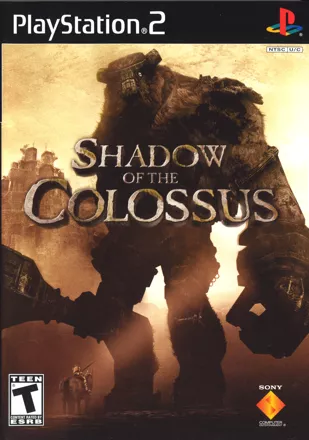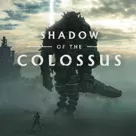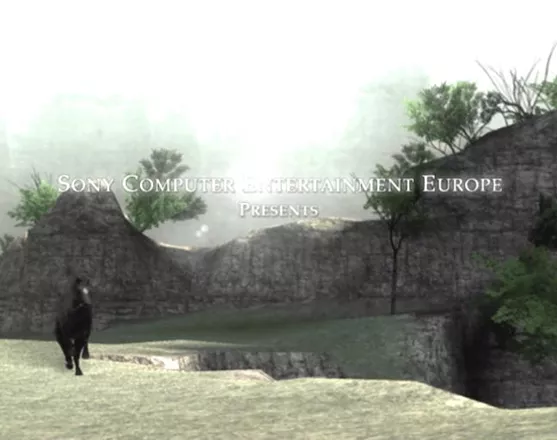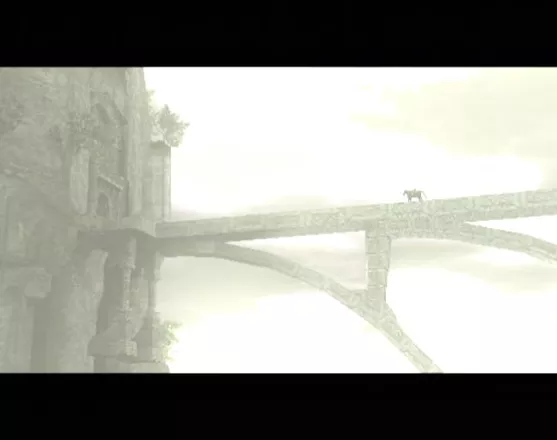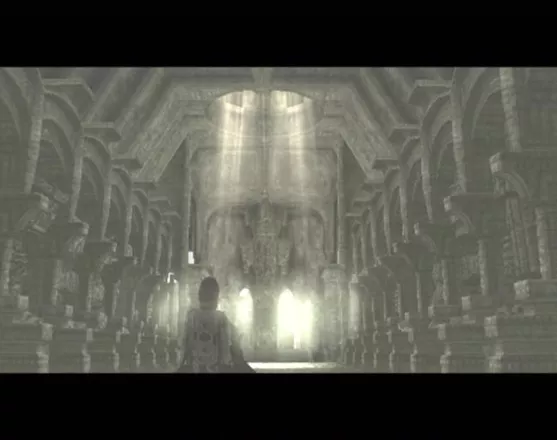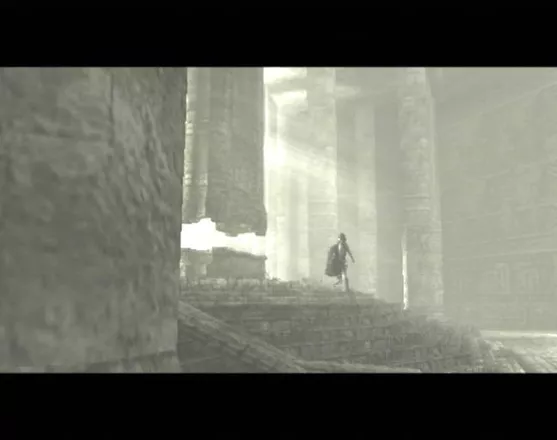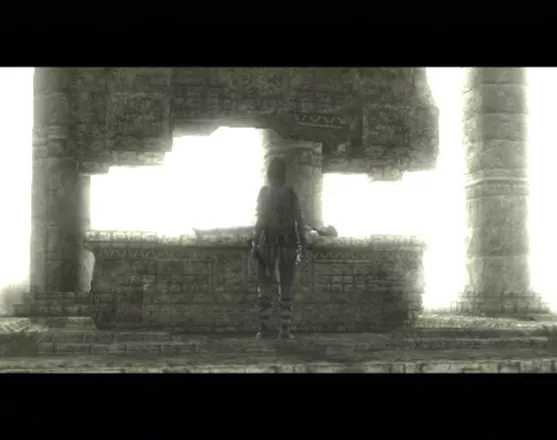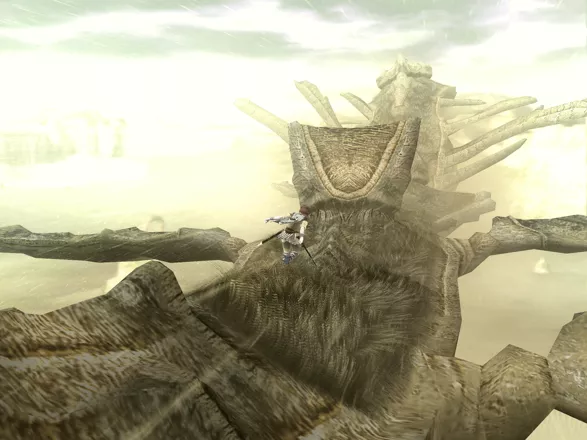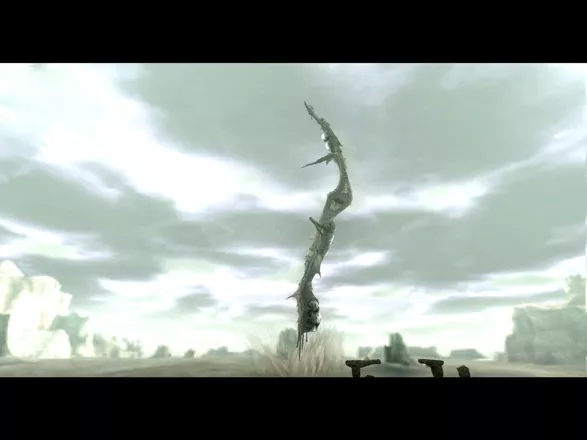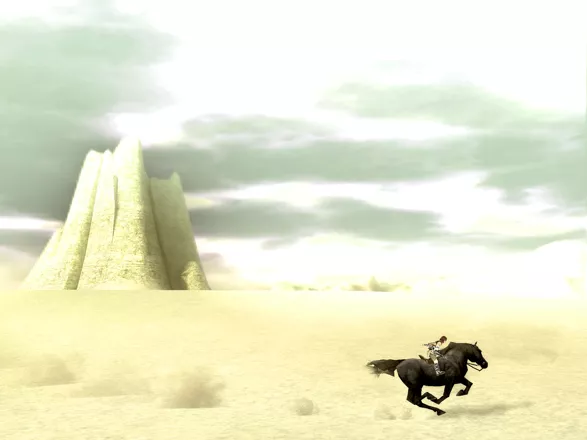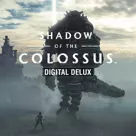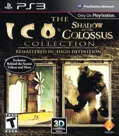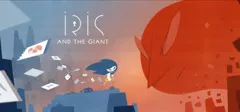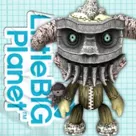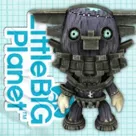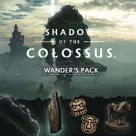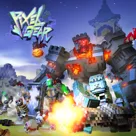Shadow of the Colossus
Description official descriptions
In an ancient time long past, a young man travels to the ends of the Earth, a place that is said to be forbidden to enter. He carries a young woman, who died from a terrible curse. He seeks the Dormin, a strange and God-like being that resides there. The Dormin is surprised that the man carries an ancient and magical sword, and speaks to the man. The man pleas for his help in bringing back the woman's cursed soul, however the being says it is the law of mortals that a dead soul cannot be brought back. He does say though, that if the man is willing to accept some heavy consequences, that there might be a way to revive her. But it will not be easy.
The hero must embark on a quest to slay the sixteen colossi, giant creatures that tower hundreds of feet above the Earth. Using his ancient sword and his horse Agro, he must travel across the immense landscape seeking the colossi to save his love. Taking the form of various animals or bipedal human-like creatures, these colossi are tough and fierce. Their skin is tougher than leather, and the armor they wear is literally rock. However, by using his ancient sword, the man can penetrate the weak spot on them and destroy the towering beings and free his love's soul.
Shadow of the Colossus is set in the same universe as ICO, and is a prequel to it. The entire game is dedicated to locating and fighting the sixteen colossi, which must be faced and defeated in a particular order. Finding the giant creatures is not always easy: the hero must mount his horse and ride through the world's vast landscapes, using his glowing sword as an indicator of the colossus' proximity. There are no enemies or hazards in the game world outside of the colossi battles. After a colossus has been found, a large-scale battle begins. Most of the colossi are huge, and much of the challenge in the battles lies in climbing on top of these creatures and staying there, while they are trying to shake the player character off. In a certain way the colossi function as hostile, moving platform stages.
The general goal in every battle is to reach the colossus' weakpoint and repeatedly stab it with the sword until he dies. Since the colossi vary greatly in shape, size, speed, intelligence, and attitude towards the hero, the player will have to adapt to different fighting styles and employ different tactics against them. Most of the battles involve extended platform action sequences, as the hero is trying to climb on the colossus and find its weak spot. Grabbing the creature's fur, timing the jumps, and getting in a good position to use the sword are often essential. Other tactics include fighting on horseback, using ranged attacks with the bow, luring the colossus into specific locations to use the environment against it, taking advantage of the terrain, etc. Environments in which battles take place are also varied, including mountains, deserts, lakes, ancient ruins, and others.
Spellings
- ワンダと巨像 - Japanese spelling
- 汪达与巨像 - Chinese spelling (simplified)
- 완다와 거상 - Korean spelling (Hangul)
Groups +
Screenshots
Promos
Videos
Add Trailer or Gameplay Video +1 point
See any errors or missing info for this game?
You can submit a correction, contribute trivia, add to a game group, add a related site or alternate title.
Credits (PlayStation 2 version)
262 People (225 developers, 37 thanks) · View all
| Game Design | |
| Planning | |
| Game Script | |
| Camera Setting | |
| Sound Setting | |
| Character Design | |
| Character Animation | |
| Effects Design | |
| Field Design | |
| [ full credits ] | |
Reviews
Critics
Average score: 92% (based on 51 ratings)
Players
Average score: 4.2 out of 5 (based on 152 ratings with 10 reviews)
The Good
Even before starting Shadow of the Colossus, one might already have an inclination as to how beautiful, how epic, or how different this game will be. And after the introduction, one might have an even greater sense of what is to come. Yet, that one still has no idea.
It is nearly impossible to describe the feeling that springs forth upon seeing the first cinematic of the first Colossus lumbering about its portion of the expansive landscape. All that was expected, or imagined, is washed away to be filled with a... an uplifting awe. If it were not for the sublime, heavy task that, you, the hero(Wander) agrees to undertake, one might be content just admiring the impressiveness and beauty of the giant. However...
There is a battle to be had. You are not entirely alone in this struggle, as you have your most reliable steed, Agro, accompanying you into danger, but it is you alone who must scale and ultimately fell the Colossus. It knows you are there and perhaps even knows why you are there. It will not allow you to simply climb, find its point of weakness and drive your sword into its body. Crushing you beneath its feet, smashing you to bits, violently thrashing you about, but you are triumphant. The Colossus is slain and there is satisfaction, albeit short-lived.
That is only one of 16. Each Colossus bringing a sense of wonderment. What will the next one look like? What is needed to be done to defeat it? Each defeat becoming less satisfying and possibly more sorrowful. One might wonder at the killing of these giants. The cinematics, the music all lending, and leading to a very heartfelt, soulful conclusion.
The Bad
Much has been said about the camera being a nuisance at times, and slight graphical errors. All can EASILY be dismissed.
There is one conscious disappointment for me. However, it will not be mentioned, for I fear it would turn you away from partaking in a tremendous experience. It did not do so for me, but it can be regarded as a bummer, and might do so for you.
The Bottom Line
Shadow of the Colossus is a game that could play a sweet, sweet melody on your heartstrings. If you prefer to experience a game, rather than just play it, Shadow certainly is one. If you prefer to play, let Shadow satisfy you.
PlayStation 2 · by SlapHappy (10) · 2006
Big is not scary; small is scary
The Good
Video games are a lot of fun. Hot damn, one thing the modern age has brought us is a never-ending supply of entertainment in the form of internet chatting, web surfing for information, compiling information for an online database as well as just playing video games. In fact, video games are at times so fun that they are difficult to put down and compel the player to not stop. This is called addiction, and there are some gamers who believe a good video game should have this addictive quality; at one time the video game magazine GamePro had it as one of its rating requirements. The assessment is a fair one in this context; fun is what people want and expect in a game, so it makes sense for them to have a game that doesn’t stop being fun. If a game is addictive, then it serves its own purpose very well as a leisure activity or “time-killer”, if you will. That’s what a game is: an activity that you partake in and, win or lose, you enjoy yourself during the time you are doing it.
Videogames are also a burgeoning expressive art form. What once was quick, simple fun has evolved to telling complex stories of ambiguous morality that may resonate deeply with the player’s emotions. From its crude beginnings, videogames have become a billion-dollar industry as a pop-culture sensation and a technological marvel. However, this balance of being both a game and as art has never been resolved. Take for example, this issue: “Do video games make people think? Do videogames challenge people such that they are different people at the end of the experience?”
This “thinking” is actively thinking, thinking to come to a conclusion that hasn’t been thought of before and not just thinking mechanically. Sure, there’s a lot of thinking going on in games. This takes a myriad of forms in the plethora of different videogame genres: action games require fast, reflexive thinking; puzzle games require abstract problem-solving; RPG’s may require moralistic decision-making. The differences are vast as are the heated discussions to which is better, but they are all the same in the as they require the player to operate within the set parameters that the game lays out for you. You are following the game; the player is making decisions only based on what the game asks of you. Once again, this is pretty much just using your brain and not thinking on your own and coming to your own conclusions.
The game play aside, what success video games have achieved somewhat in terms of thinking are games that “make you think”. Games have matured in the recent past by tackling social issues and telling compelling stories that people affect people long after the game is over. One quick example is Dragon Quest VIII: Journey of the Cursed King, where despite fighting cute monsters in random battles the main story has themes of child abandonment, sibling rivalry, a death in the family as well as racism (or monsterism, though this is minor). Modern video games are not slow to tackle new and unproven themes that once may have been too edgy for an audience.
However, a video game is still a game, no matter how well a video game tells a story or challenges the player to think outside the box. Besides anything else a game aspires to be, they must be fun to play. The entire experience of having a wonderful story told to you with amazing graphics and wonderful music is compromised by one thing: you are playing a video game with the purpose to win it. Almost every game made has a “game over” screen, and as a gamer you’ll do everything you can not to be staring at it. Whatever thinking you do while playing a video game usually has to do with the video game itself; if it is a smart and good video game then it will shape your thinking to become addicted to the game play. Addiction is not thinking; addiction is doing something without thinking.
And then you have Shadow of the Colossus, a masterpiece of a game that is so good people are usually left sputtering adjectives of praise but not able to describe why it’s so good. The likes of this game, which pits the unknown protagonist against 16 epic boss fights in order to save a dead woman, has never been seen before and likely its kind won’t be seen again. It’s a unique experience that raises the bar as to what a video game can achieve in terms of artistic expression. Lots have been written about the various colossi and the “purity” of boiling a game down to just the boss battles in which a boss is the anthropomorphism of a video game level. Shadow of the Colossus is an unique blend of having action/puzzle game play in an adventure game; it tells a touching story that is very out of place for a video game, and succeeds because of it. It is an extremely immersive game that is emotive without being crass and manipulative. It is the most well-made video game created because you will understand and appreciate exactly what the developers are trying to say and do.
You’ve read it all before in any of the hundreds of reviews that universally praise this game. While the praise is well-deserved, Shadow of the Colossus succeeds as a work of art because it does something that just about no video game ever made does: it lets you think.
That’s right: it lets you think. It doesn’t crowd your brain with superfluous decision making or needless details. You have a set objective, and to achieve that you must best these colossi, whom you can figure out how to beat by just looking at them. This takes place in a set world that is extremely detailed and immersive with no loading times. This is a simple and pure game, and because the set parameters are so few and unexplained—you must kill these colossi in this beautiful world without knowing why—as you play the game it lets you think.
That’s “let you think”, not “make you think”. Shadow of the Colossus isn’t so self-important to take itself so seriously. If it has anything important to say, then it challenges you to figure it out. This game is similar to the brilliance of Bioshock that permits the player to be as immersive in the story if they choose to do so, but in Shadow of the Colossus the details must be filled in by the player themselves because the story is told so sparsely and mysteriously. As in both games, a player can blaze through from beginning to end, enjoy themselves and be witness to a marvelous experience, and not know why.
This concept of “letting you think” is no better exemplified than by the game’s most important characters: the environment and the player’s horse, Agro. It is riding through this “cursed land” on your beloved horse that is the essence of the game, not the novelty of solely fighting epic boss battles where you have to climb on somebody to kill them. Take for instance: it is evident a vast percentage of the resources available for game development where allocated to making the world environment and to making the horse run and operate properly. The gigantic world is beautifully detailed and well designed and runs without any load times whatsoever. Agro is the most realistic depiction of a horse in a video game (compared to Gun, for example), and besides accurate, realistic-type controls Agro features a smooth transition from a walk to a trot to a gallop, no mean feat for an animal with four legs.
If the stars of Shadow of the Colossus are the colossi themselves, then wouldn’t a prudent development decision be to focus just on the colossi themselves? If you devoted the resources making the world environment and the horse (who is only used to as part of the colossi battles for a regretful few) to making the colossi, then we would have a game that could feature twice as many colossi, or ultra-smart colossus A.I. that could quiz you what your favorite color is before you cross a bridge. Wouldn’t more and better colossi make a better Shadow of the Colossus game?
No. If this decision was made and, for example, the game took place in a castle where you walk from room to room (like ICO), all the inspiration and magic would be gone because there isn’t a context for things to happen in. This can be seen in the game itself; after beating it once, the game features a challenge mode where you can walk up to the statue of any one colossus (all located in the same room) to play and replay the boss fights; fun, but not part of the amazing game experience.
Riding through the huge world is the real essence of the game. Just like every other part of the game, the environment is simplified and devoid of any real animals, save some tiny animals—it’s just riding. There are no random battles to encounter to level up your stats, as there are no NPC’s to encounter to take quests and buy weapons. It is a pure element, just like all the elements in this game. After receiving orders as to which colossus to whack next—the fantasy world equivalent of a GTA crime boss you take missions for—the player rides to the next destination with only your magical sword to serve as a compass. For a game that tells its story so subtly and is very stingy with any concrete details, this journey is the best part of the game because even though you are riding to the next colossus the real action takes place in your own damn brain.
That’s right, for this day and age where everyone demands better graphics the best part of Shadow of the Colossus takes place in your own imagination. As the distance grows, so does the anticipation. The mind fills with questions: What will the next colossus look like? If the last one was so tough to beat, how will I beat this one? What is the purpose of these colossi? Who is the mysterious woman I’m trying to save? But most importantly, why? Why am I trying to kill these magnificent creatures? Why do I feel regret even as I inch closer to my objective?
Shadow of the Colossus doesn’t ask you these questions; no, it lets you think for yourself. As you’re riding and thinking about these things your thoughts will drift to other subjects, but since your mind is already in a critical state of mind you are likely to do some more. That’s right, this game fools you into thinking for yourself. Genius, this is nothing short of genius. This game transcends the parameters it sets itself becomes something much more by using the best story teller you know: yourself.
Shadow of the Colossus is a “pure” game where everything is exactly as it should be. It is a perfect blend of technology, art and inspiration. Everything about this game is as it should be: the mysterious story matches every blade of grass on the lush landscape; the tense gripping battles matches the long, silent, contemplative ride through the wilderness. This is a game that will never, ever age. 100 hundred years from now people will still appreciate this game because it couldn’t be any better, not now nor then.
The Bad
No customizable songs available on non-existent horse radio. Can’t stick a sword up a colossus’ ass. Was expecting a final boss so big that a spaceship is required to build and fly to the moon from which you can time a jump to grab onto the colossus’ toe hair.
The Bottom Line
Man, I was a bit disappointed by the difficulty of this game. I breezed through a couple of them and said out loud to the TV, “Wha? But that’s so easy!” I did need to look up a faq for the two smallest “lion” colossi, shamefully, and the last guy I just spoiled it for myself and read it before I started because I was getting “colossi-itis” and just wanted the satisfaction of ending this great game.
I went and read through a faq that tried to explain EVERYTHING about the story, and I just have to say: man, you nerds, stop trying to figure magic out. The game is great because it’s mysterious. As in the cult film “Donnie Darko” (2001), it’s cool and interesting because you have no pin-wheelin’ idea what’s going on; later on in the Director’s Cut release where everything was explained, the movie just wasn’t cool nor interesting anymore. Man, just because you think you know something doesn’t make it better or your enjoyment of it better.
The tagline to this review comes from David Lynch; he replied thusly when asked why he often has very tiny people in his movies (for example, the end of “Mulholland Dr.” (2001)). Dave’s got a point, you know; it’s tough being a giant colossus.
PlayStation 2 · by lasttoblame (414) · 2008
Desperate love leads a young man to slay the mightiest of giants.
The Good
Most gamers have heard of Shadow of the Colossus by now. But what about the average person who's never even heard of this game? Describing it as "A game where you slay 16 huge monsters across a empty world." is criminally misleading. Yes, you have to destroy 16 giants, but why?
Love. That's the reason you (The wanderer in the game.) came to this land. To seek out a ancient cursed shrine. On your horse (Agro.), lies the body of young woman. She was sacrificed for reasons you can't fathom. But you love her, and would go to these accursed lands, just to save her. It's said, a being named Dormin lives there and it can bring back the souls of the dead. As you lay your love on a altar in the central shrine, Dormin speaks to you. As you speak to the godlike being, it offers to bring back the soul of the maiden. But only if you slay sixteen mighty beings called Colossus. Your love for her is so deep and desperate, you agree to go out into this barren land time has buried, and set out on the impossible task.
It is only you and Agro on this journey. Your only weapons are a magic sword, and a bow. The sword, when held up in sunlight, reflects intense beams of light. As you turn around left or right, the beams start to converge, and become one beam at a certain point. The merged beams point to the location of the colossi. Go in that direction, and you will find it. But it's not like going point a to b. This a wholly contained world you must travel across to get to it. There are no neatly divided sections. It's remarkably consistent in style, no matter how different the environment.
Great stone ruins are scattered across your path. Withered and hewn by the forces of time, they loom over you, like they were carved by gods. Stone temples carved into mountain sides out of sheer will, are slowly filling with dust. Scant traces of road can be found at bridges, barely holding onto the chasms they span. Stone steps and arches that have no more travelers. Only weeds and ancient dust. Crumbling canyon walls disguise the road you ride upon. Large stones that tumbled in make it uneven, grass and dirt hide what's underneath. It seems a work of nature, until you come across road markers. Untraveled, neglected roads that lead to dead cities. Great vaulted dwelling places, large open stone yard, water drains and tall spires is what they're made of. Lonely for nobody now, it crumbles away where nobody can see it. How odd that it's bright and covered in green foliage.
One can't help but wonder what great people once lived here. What magnitude of disaster makes a place so ruinous? How long ago was this land forsaken? All fruitless questions, as no answers are ever given. Only you are left to wonder why.
Perhaps it isn't so sad. Nature seems to keep this place company, even while aggressively eroding it. Weeds take root on crumbling stone edifices no matter how shallow the soil. Great washes of green cover cliffs, canyons and plains. The forests are damp, shady, and cool. Streams flowing from places you'll never see, fall over deep chasms, slowly eroding them into cliffs. A stray lizard or bird is almost the only type of life you'll see in these lands. Even fish don't appear that often. They swim in flooded court yards, that are now like small lakes. Large collections broken of stone collect at the bottom of high canyon walls. The brightest and most beautiful green grass grows there. It leads into dry, blighted areas, where it seems nothing lives. Not even weeds deem those places fit to live in. The sun doesn't even care to shed much light on this place. The desert seems like a relief from this wholly dead and depressing place. Low dunes undulated across it's openness. Only occasionally interrupted by a free standing set of stones, or a few blocks of a building long gone.
All of this describes the world you explore. You think the landscapes alone are pushing the PS2 to its limits? Just look at Agro. He moves like a real horse. He has momentum when he runs, and takes a moment to slow down. He even stands around like a real horse. Even you move like a real human being. If just the two of you are so well portrayed, what will these colossi be like? The time for wondering is over. You have arrived at your destination. You have to climb a high wall to get to it though. You're suddenly reminded that Agro is the only living thing in these lands that cares for you, and he is your only source of companionship. As you climb off of him, you can give him a comforting pat with the circle button, unsure whether you'll ever see him again. As you pull up the cliff, the ground starts to shake. Dust comes in large drifts. Trees, barely alive shake all the way to their roots. And then it appears, the first colossus.
It lumbers across the plateau unaware of your presence. It stops and stands at the other end, just looking around. It's larger than you dared even imagine. You pull out you bow, and let loose one arrow into its back. It groans, and turns to face you. It's looking right. At. You. It starts moving towards you. Now is the time to start running towards it.
Suicide you might say. But the only way to defeat it is to climb it, and find its weak spots. Simply plugging it with arrows and slashing at it wildly won't subdue the giant. But how? Its skin is covered in fur and protective stone! Panic sets in. Then it dawns on you. You can grab it's fur and armor to get where you need to go. You climb it's back, and jump to each armor piece. It'll try to shake you off. You have a energy meter that wears down the more you hold onto the the behemoth. It will momentarily stay still long enough to let go of it's fur and let you run to it's weak spot, refilling your energy in the process. You pull out your magic sword to make the spot appear glowing. You grab hold on top of the spot, but the colossus thrashes violently to shake you off. After each thrash is the time to strike, plunging your sword in deep, and pulling it out again and again until his life bar is empty. Great plumes of black blood gush out, almost obscuring your view. The throws become even more violent until the last stab drains all of the creatures resolve to fight, and to live. It falls with such force, the ground all around it shudders and shatters. A great thing is now dead. As it falls, you see the light literally go out in its eyes. Its essence, is a black vapor that envelopes it, evaporates, and then is drawn into you. This surge of energy makes you collapse, and black out.
The game prompts you to save, and you wake up at the central shrine. Weary, and exhausted, you rise to your feet. A idol representing the colossus you just destroyed, lights up with energy, and crumbles. Dormin describes the next colossus, and you start a new trek for the next one. Agro comes trotting in after a few moments, somehow knowing where his master is. But the journey and colossus are not the same as the last. Some live in lakes, long undisturbed. Others live in neglected, secret gardens. There are even those that fly. Soaring high in the sky, dipping and rising up with ease.
They all move with awe inspiring confidence. They are often unaware of your presence. Why should they care? You are nothing more than a fast moving blot darting around their feet. Others, so hungry for sport or destruction, see you as a excuse to wantonly chase or destroy. Each one is so intricately detailed with fur, armor, and mottled skin. The texture capabilities of the PS2 are pushed to the limit on these moving mountains. They're almost XBOX quality. It pushes animation to the brink as well. Every part of their bodies are articulated. They have weight, momentum, and fierce intelligence. Some relentlessly pursue you. Others try their best to avoid you. Just trying to figure out how to get onto them later in the game represents most of the challenge.
After a while, you start to feel bad for them. Such proud and magnificent beings, slain in a matter of moments. But it is for your love you do this. Surely these beings did something to deserve their fate. Why else would they such life draining spots. Perhaps they were cursed with them? Maybe they destroyed this land? Or maybe Dormin is lying to you. Has it some grudge against them? Until the end, you are given no answers. If you do not act, it will not restore the life of your loved one. If you continue, you might be being used for murder. Your lover for her is too strong. You continue.
Greater strength is needed to grasp the later colossi. Each one you defeat gives you greater health and strength, but it can be gained additionally by eating fruit from certain trees scattered across the land and collecting white tailed lizards. Those lizards are only found at save shrines. Small shrines that mimic the central shrine, can restore your health, and save you much backtracking on longer journeys.
The last colossus is the longest journey of all. It seems like a eternity to get there, but at the end, lies the last battle for the soul of your love. Have you forgotten? All these battles, lonely trips and hardships were for her. You are ragged, filthy, and exhausted. Your skin has a strange color to it. No longer the same as you started, but not noticeably darker. You have no time. The final battle is here.
All of the pretty words I've written so far can't possibly describe how epic (Yes, I know how overused that word is.) the final battle is. It truly must be experienced first hand. The ending is unexpected, horrifying, beautiful, and surprising hopeful. That's all I'll say. The game is a experience you have to play to fully understand, no matter how long a review describes it.
It really feels like a living, breathing world, and all the sounds that go with it. Wind rolling across the plains, birds chirping in the forest, soothing water falling over the cliffs, and the stillness of the desert. A Sweeping musical score plays just before, and during battle. Other times, it plays softly for intimate, emotionally charged moments. But for the most part, there is no music. Why would you need it? It would only distract from the natural sounds in the landscape.
I can't come up with anything else without spoiling the game, so I'll tell you about some of the other features of the game. Unlike ICO, there are extras to unlock replaying the game. New items like masks, harder difficulty and new weapons are a few. But the biggest reason is to explore the landscape. Even after defeating all the colossus, there are still huge amounts of land to be explored.
That's about it for the good. Now unfortunately, comes the bad.
The Bad
Like nothing else in the game, the camera really fucks it all up sometimes. Team ICO apparently couldn't decide whether or not to make the camera manual or auto controlled. After moving, in a few seconds, it goes back to the default. It doesn't matter much when you're traveling across the landscape, but in the heat of battle it can get pretty frustrating.
The controls are somewhat erratic too. Just trying to get on Agro sometimes will drive you crazy! And he doesn't keep a steady speed very well, so you have to keep tapping the X button to keep him going.
The music seems like it has a hard time keeping up with what's on screen sometimes. Depending on how far away you are from the colossus, the music gets louder or softer. Sometimes it takes it a few seconds to get up to speed when you're suddenly close to it again.
That pretty much wraps things up.
The Bottom Line
Shadow of the Colossus is a game that has no equal. There's simply been nothing like it before or since. Anybody who considers themselves a gamer should play this game. Period. For somebody who's never played this game, go out and find this game. Period. These closing words may seem too brief, but I mean, come on! I just wrote a huge review trying to describe the game to you! I loved it, and that's all I can say.
PlayStation 2 · by GAMEBOY COLOR! (1990) · 2011
Discussion
| Subject | By | Date |
|---|---|---|
| Tips for riding Agro | Halleck (389) | Jan 26, 2011 |
| This is amazing | Unicorn Lynx (181775) | Jul 31, 2007 |
Trivia
1001 Video Games
The PS2 version of Shadow of the Colossus appears in the book 1001 Video Games You Must Play Before You Die by General Editor Tony Mott.
Character
Throughout the game, the main character's appearance continually gets worse from the physical and mental strain of fighting the colossi and from the strain of the dark spirits possessing him. His hair and clothes will gradually get dirtier, and his clothes will eventually tear in numerous places. Also, his face will scar and get paler as the game continues.
Demake
In September 2008 the game was "demade" for the TIGSource Bootleg Demakes competition as Hold me closer, Giant Dancer.
Development
Shadow of the Colossus is known for pushing the PS2 hardware to its limits. For example, SotC features fake HDR (High Dynamic Range) rendering, even though the PS2 hardware doesn't really support HDR.
Another example for this is the the "fur shader" - the colossi are very hairy and are the fur is rendered quite convincingly. The fur also features some simulated anisotropic lighting, giving the fur realistic highlights. Again, the common way to achieve this is not possible on the PS2, but the game developers managed to approximate this.
The game features many other technological achievements. Some are visible such as self-shadowing, and some are behind the scenes, such as the complex memory management system that allows for the huge game world without loading time or memory fragmentation.
Further details can be found in The Making of "Shadow of the Colossus" (5 MB pdf), which includes explanations from the game's developers, and in an analysis by Jonathan Cooper
Extras
The PAL release comes in a cardboard packaging containing four unique postcards with art work depicting moments from the game. It also includes camera interviews with artistic partners and creative directors Fumito Ueda and Kenjj Kaido to get a look behind the scenes, an image gallery with concept sketches and in-game stills, and the original game trailer to ICO.
References
Various philosophical elements are present in the game. For instance, Dormin is reminiscent of the biblical character Nimrod. Nimrod is a biblical king credited for the creation of the Tower of Babel, whose purpose was to build a stairway into the heavens. Before its completion, the builders tongues are mixed up into different languages (which, according to the Bible, justifies the many languages of the Earth). As well, the Tower of Babel is said to be one of the tallest structures on the Earth, and could be seen from all parts of the Earth.
The shrine of worship is completely symbolic of the Tower of Babel. Dormin is meant to represent Nimrod, the builder of the shrine, and if one notices closely, Dormin is an exact anagram of Nimrod. As well, through a secret method the character is able to climb the tower and reach a paradise, symbolic of a Heaven or other after-life paradise (notice that in the story, Mono and Wander are only able to climb to the top of the tower once they are free of Dormin, who represents Sin and evil). The tower is obviously the hugest structure on the map, and can be seen from all parts of the map (if the view is not obstructed) As well, before Dormin can ascend to total power (as if ascending into Heaven), he is split up into 16 parts, thus completing the image of the builders being divided by their changed languages.
References to the game
- The basic premise of this game (enormous monsters with light-up self-destruct buttons) is riffed on in a Penny Arcade webcomic strip dated October 21st, 2005.
- Shadow of the Colossus is referenced in the movie Reign over Me (2007) where actor Adam Sandler is addicted to it.
Savegame import
If the player has a saved game from ICO on the memory card in slot 1, Aggro's diamond shaped mark on his head will be replaced with the logo for ICO; a horn/tooth-like shape.
Awards
- 4Players
- 2006 – Best Game of the Year
- 2006 – Best PlayStation 2 Game of the Year
- 2006 – Best Action-Adventure of the Year
- 2006 – Most Impressive Boss of the Year (for Colossus 16)
- 2006 – Best Original Soundtrack of the Year
- Electronic Gaming Monthly
- February 2006 - #192 out of 200 on the "Greatest Games of Their Time" list
- GameSpy
- 2005 – #5 PS2 Game of the Year
Information also contributed by Big John WV, Christian Moleman, hribek, Indra was here, Mickey Gabel, Pseudo_Intellectual, Robstein and Sciere
Analytics
Upgrade to MobyPro to view research rankings!
Related Sites +
-
Cursedlands.com
A resource site for ICO and Shadow of the Colossus -
Making of "Shadow of the Colossus" (5 MB pdf)
Explanations from the game's developers how SOTC was made. English translation. -
Shadow of the Colossus
Official game website -
Wikipedia: Shadow of the Colossus
Information about Shadow of the Colossus at Wikipedia -
Zarf's Mini-Review
A mini-review of Shadow of the Colossus by Interactive Fiction developer Andrew Plotkin (November, 2005).
Identifiers +
Contribute
Are you familiar with this game? Help document and preserve this entry in video game history! If your contribution is approved, you will earn points and be credited as a contributor.
Contributors to this Entry
Game added by Terrence Bosky.
PlayStation 3 added by Kabushi.
Additional contributors: Unicorn Lynx, Sciere, Matt Neuteboom, Namaenashi, Zeppin, DreinIX, Arejarn, hribek, Patrick Bregger, Rik Hideto, FatherJack.
Game added November 7, 2005. Last modified February 16, 2024.
